Ru Peng
DataMan: Data Manager for Pre-training Large Language Models
Feb 26, 2025Abstract:The performance emergence of large language models (LLMs) driven by data scaling laws makes the selection of pre-training data increasingly important. However, existing methods rely on limited heuristics and human intuition, lacking comprehensive and clear guidelines. To address this, we are inspired by ``reverse thinking'' -- prompting LLMs to self-identify which criteria benefit its performance. As its pre-training capabilities are related to perplexity (PPL), we derive 14 quality criteria from the causes of text perplexity anomalies and introduce 15 common application domains to support domain mixing. In this paper, we train a Data Manager (DataMan) to learn quality ratings and domain recognition from pointwise rating, and use it to annotate a 447B token pre-training corpus with 14 quality ratings and domain type. Our experiments validate our approach, using DataMan to select 30B tokens to train a 1.3B-parameter language model, demonstrating significant improvements in in-context learning (ICL), perplexity, and instruction-following ability over the state-of-the-art baseline. The best-performing model, based on the Overall Score l=5 surpasses a model trained with 50% more data using uniform sampling. We continue pre-training with high-rated, domain-specific data annotated by DataMan to enhance domain-specific ICL performance and thus verify DataMan's domain mixing ability. Our findings emphasize the importance of quality ranking, the complementary nature of quality criteria, and their low correlation with perplexity, analyzing misalignment between PPL and ICL performance. We also thoroughly analyzed our pre-training dataset, examining its composition, the distribution of quality ratings, and the original document sources.
Predicting Rewards Alongside Tokens: Non-disruptive Parameter Insertion for Efficient Inference Intervention in Large Language Model
Aug 20, 2024



Abstract:Transformer-based large language models (LLMs) exhibit limitations such as generating unsafe responses, unreliable reasoning, etc. Existing inference intervention approaches attempt to mitigate these issues by finetuning additional models to produce calibration signals (such as rewards) that guide the LLM's decoding process. However, this solution introduces substantial time and space overhead due to the separate models required. This work proposes Non-disruptive parameters insertion (Otter), inserting extra parameters into the transformer architecture to predict calibration signals along with the original LLM output. Otter offers state-of-the-art performance on multiple demanding tasks while saving up to 86.5\% extra space and 98.5\% extra time. Furthermore, Otter seamlessly integrates with existing inference engines, requiring only a one-line code change, and the original model response remains accessible after the parameter insertion. Our code is publicly available at \url{https://github.com/chenhan97/Otter}
Qwen2 Technical Report
Jul 16, 2024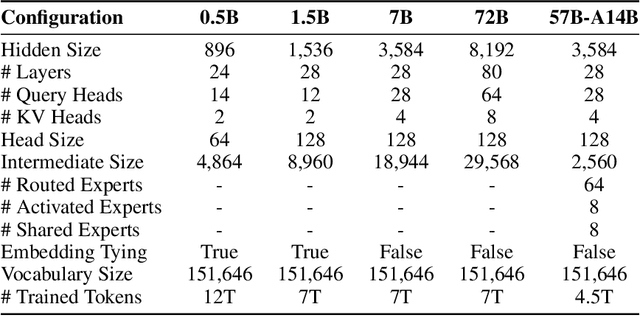
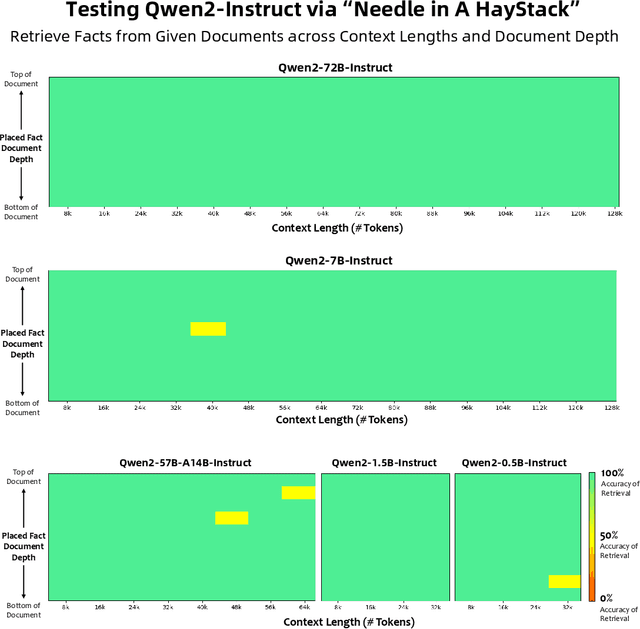
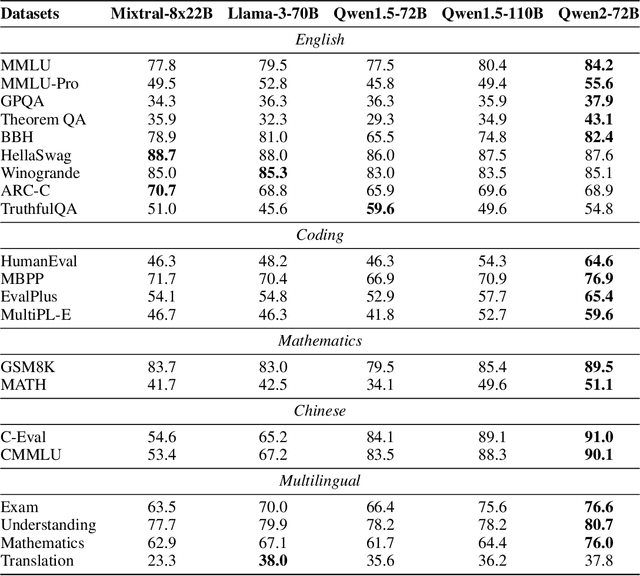
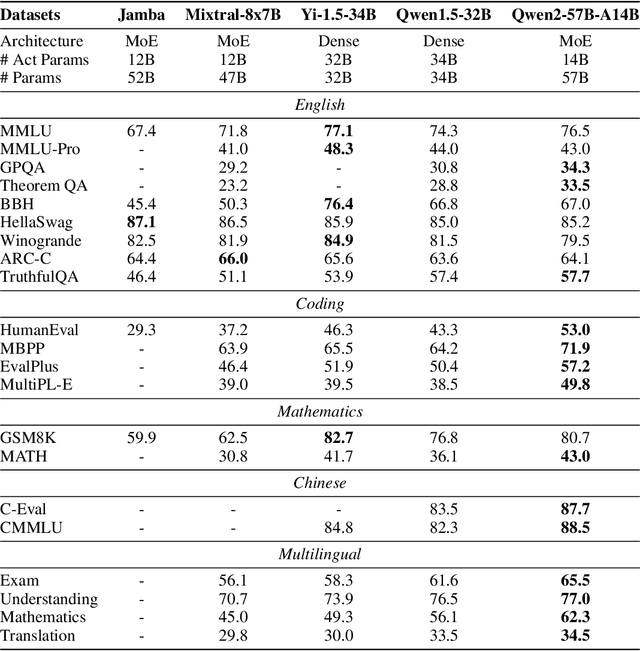
Abstract:This report introduces the Qwen2 series, the latest addition to our large language models and large multimodal models. We release a comprehensive suite of foundational and instruction-tuned language models, encompassing a parameter range from 0.5 to 72 billion, featuring dense models and a Mixture-of-Experts model. Qwen2 surpasses most prior open-weight models, including its predecessor Qwen1.5, and exhibits competitive performance relative to proprietary models across diverse benchmarks on language understanding, generation, multilingual proficiency, coding, mathematics, and reasoning. The flagship model, Qwen2-72B, showcases remarkable performance: 84.2 on MMLU, 37.9 on GPQA, 64.6 on HumanEval, 89.5 on GSM8K, and 82.4 on BBH as a base language model. The instruction-tuned variant, Qwen2-72B-Instruct, attains 9.1 on MT-Bench, 48.1 on Arena-Hard, and 35.7 on LiveCodeBench. Moreover, Qwen2 demonstrates robust multilingual capabilities, proficient in approximately 30 languages, spanning English, Chinese, Spanish, French, German, Arabic, Russian, Korean, Japanese, Thai, Vietnamese, and more, underscoring its versatility and global reach. To foster community innovation and accessibility, we have made the Qwen2 model weights openly available on Hugging Face and ModelScope, and the supplementary materials including example code on GitHub. These platforms also include resources for quantization, fine-tuning, and deployment, facilitating a wide range of applications and research endeavors.
DotaMath: Decomposition of Thought with Code Assistance and Self-correction for Mathematical Reasoning
Jul 04, 2024Abstract:Large language models (LLMs) have made impressive progress in handling simple math problems, yet they still struggle with more challenging and complex mathematical tasks. In this paper, we introduce a series of LLMs that employs the Decomposition of thought with code assistance and self-correction for mathematical reasoning, dubbed as DotaMath. DotaMath models tackle complex mathematical tasks by decomposing them into simpler logical subtasks, leveraging code to solve these subtasks, obtaining fine-grained feedback from the code interpreter, and engaging in self-reflection and correction. By annotating diverse interactive tool-use trajectories and employing query evolution on GSM8K and MATH datasets, we generate an instruction fine-tuning dataset called DotaMathQA with 574K query-response pairs. We train a series of base LLMs using imitation learning on DotaMathQA, resulting in DotaMath models that achieve remarkable performance compared to open-source LLMs across various in-domain and out-of-domain benchmarks. Notably, DotaMath-deepseek-7B showcases an outstanding performance of 64.8% on the competitive MATH dataset and 86.7% on GSM8K. Besides, DotaMath-deepseek-7B maintains strong competitiveness on a series of in-domain and out-of-domain benchmarks (Avg. 80.1%). Looking forward, we anticipate that the DotaMath paradigm will open new pathways for addressing intricate mathematical problems. Our code is publicly available at https://github.com/ChengpengLi1003/DotaMath.
Inference-Time Decontamination: Reusing Leaked Benchmarks for Large Language Model Evaluation
Jun 20, 2024Abstract:The training process of large language models (LLMs) often involves varying degrees of test data contamination. Although current LLMs are achieving increasingly better performance on various benchmarks, their performance in practical applications does not always match their benchmark results. Leakage of benchmarks can prevent the accurate assessment of LLMs' true performance. However, constructing new benchmarks is costly, labor-intensive and still carries the risk of leakage. Therefore, in this paper, we ask the question, Can we reuse these leaked benchmarks for LLM evaluation? We propose Inference-Time Decontamination (ITD) to address this issue by detecting and rewriting leaked samples without altering their difficulties. ITD can mitigate performance inflation caused by memorizing leaked benchmarks. Our proof-of-concept experiments demonstrate that ITD reduces inflated accuracy by 22.9% on GSM8K and 19.0% on MMLU. On MMLU, using Inference-time Decontamination can lead to a decrease in the results of Phi3 and Mistral by 6.7% and 3.6% respectively. We hope that ITD can provide more truthful evaluation results for large language models.
DORY: Deliberative Prompt Recovery for LLM
May 31, 2024Abstract:Prompt recovery in large language models (LLMs) is crucial for understanding how LLMs work and addressing concerns regarding privacy, copyright, etc. The trend towards inference-only APIs complicates this task by restricting access to essential outputs for recovery. To tackle this challenge, we extract prompt-related information from limited outputs and identify a strong(negative) correlation between output probability-based uncertainty and the success of prompt recovery. This finding led to the development of Deliberative PrOmpt RecoverY (DORY), our novel approach that leverages uncertainty to recover prompts accurately. DORY involves reconstructing drafts from outputs, refining these with hints, and filtering out noise based on uncertainty. Our evaluation across diverse LLMs and prompt benchmarks shows that DORY outperforms existing baselines, improving performance by approximately 10.82% and establishing a new state-of-the-art record in prompt recovery tasks. Significantly, DORY operates using a single LLM without any external resources or model, offering a cost-effective, user-friendly prompt recovery solution.
Energy-based Automated Model Evaluation
Jan 25, 2024



Abstract:The conventional evaluation protocols on machine learning models rely heavily on a labeled, i.i.d-assumed testing dataset, which is not often present in real world applications. The Automated Model Evaluation (AutoEval) shows an alternative to this traditional workflow, by forming a proximal prediction pipeline of the testing performance without the presence of ground-truth labels. Despite its recent successes, the AutoEval frameworks still suffer from an overconfidence issue, substantial storage and computational cost. In that regard, we propose a novel measure -- Meta-Distribution Energy (MDE) -- that allows the AutoEval framework to be both more efficient and effective. The core of the MDE is to establish a meta-distribution statistic, on the information (energy) associated with individual samples, then offer a smoother representation enabled by energy-based learning. We further provide our theoretical insights by connecting the MDE with the classification loss. We provide extensive experiments across modalities, datasets and different architectural backbones to validate MDE's validity, together with its superiority compared with prior approaches. We also prove MDE's versatility by showing its seamless integration with large-scale models, and easy adaption to learning scenarios with noisy- or imbalanced- labels. Code and data are available: https://github.com/pengr/Energy_AutoEval
CAME: Contrastive Automated Model Evaluation
Aug 22, 2023


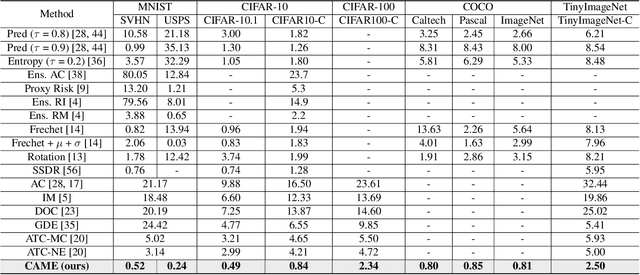
Abstract:The Automated Model Evaluation (AutoEval) framework entertains the possibility of evaluating a trained machine learning model without resorting to a labeled testing set. Despite the promise and some decent results, the existing AutoEval methods heavily rely on computing distribution shifts between the unlabelled testing set and the training set. We believe this reliance on the training set becomes another obstacle in shipping this technology to real-world ML development. In this work, we propose Contrastive Automatic Model Evaluation (CAME), a novel AutoEval framework that is rid of involving training set in the loop. The core idea of CAME bases on a theoretical analysis which bonds the model performance with a contrastive loss. Further, with extensive empirical validation, we manage to set up a predictable relationship between the two, simply by deducing on the unlabeled/unseen testing set. The resulting framework CAME establishes a new SOTA results for AutoEval by surpassing prior work significantly.
Better Sign Language Translation with Monolingual Data
Apr 21, 2023Abstract:Sign language translation (SLT) systems, which are often decomposed into video-to-gloss (V2G) recognition and gloss-to-text (G2T) translation through the pivot gloss, heavily relies on the availability of large-scale parallel G2T pairs. However, the manual annotation of pivot gloss, which is a sequence of transcribed written-language words in the order in which they are signed, further exacerbates the scarcity of data for SLT. To address this issue, this paper proposes a simple and efficient rule transformation method to transcribe the large-scale target monolingual data into its pseudo glosses automatically for enhancing the SLT translation. Empirical results show that the proposed approach can significantly improve the performance of SLT, especially achieving state-of-the-art results on two SLT benchmark datasets PHEONIX-WEATHER 2014T and ASLG-PC12. Our code has been released at: https://github.com/pengr/Mono\_SLT.
Distill the Image to Nowhere: Inversion Knowledge Distillation for Multimodal Machine Translation
Oct 10, 2022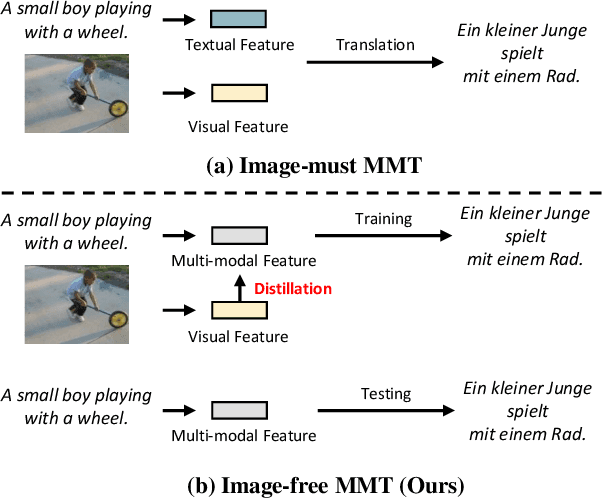
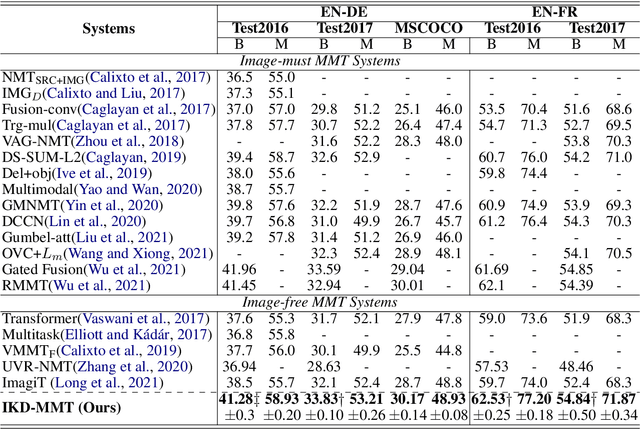
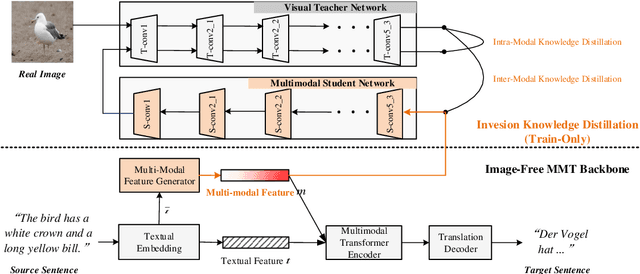
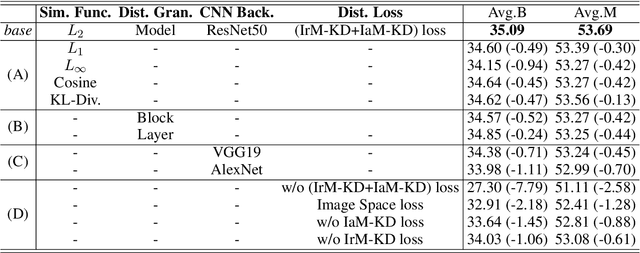
Abstract:Past works on multimodal machine translation (MMT) elevate bilingual setup by incorporating additional aligned vision information. However, an image-must requirement of the multimodal dataset largely hinders MMT's development -- namely that it demands an aligned form of [image, source text, target text]. This limitation is generally troublesome during the inference phase especially when the aligned image is not provided as in the normal NMT setup. Thus, in this work, we introduce IKD-MMT, a novel MMT framework to support the image-free inference phase via an inversion knowledge distillation scheme. In particular, a multimodal feature generator is executed with a knowledge distillation module, which directly generates the multimodal feature from (only) source texts as the input. While there have been a few prior works entertaining the possibility to support image-free inference for machine translation, their performances have yet to rival the image-must translation. In our experiments, we identify our method as the first image-free approach to comprehensively rival or even surpass (almost) all image-must frameworks, and achieved the state-of-the-art result on the often-used Multi30k benchmark. Our code and data are available at: https://github.com/pengr/IKD-mmt/tree/master..
 Add to Chrome
Add to Chrome Add to Firefox
Add to Firefox Add to Edge
Add to Edge